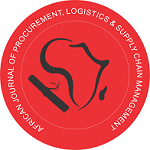Authors: 1Appohwood Vilbert Mcobrein | 2Makafui R. A. Ackah
1,2Department of Procurement & Supply Chain Management,
1,2Accra Technical University
Email: vilbertappohwood@gmail.com | makafuiagboyi@gmail.com
Abstract
This project work addressed assessing the challenges in supply chain of health commodities in the health industry. Supply chain management should be given the prominence it deserves in order for the business to stay competitive, flexible for the demand and service at low cost. Supply chain is difficult to manage and control, and inventory managers find it challenging to know when to order and how much to order. The research was descriptive in nature and was conducted through the use of quantitative research methods. This projects was divided into five chapters, chapter one being the introductory analysis, providing definitions and nature of supply chain management practice. Chapter two explained different authors view on the subject matter based on the topic. Chapter three is the methodology which explained the method the researcher used in achieving its results. Chapter four is the presentation of data and discussion. Data are provided in a tabular form and analyzed using simple percentage method. Chapter five is the conclusion which is drawn based on the research findings and recommendation are made on how to improve supply chain management practice in health sectors and other organizations. The objectives of the study were, to identify the cause of inadequate forecasting of health commodities in the supply chain, to assess the factors that cause inadequate funding of health commodities in the supply chain in Regional Medical Stores, to investigate the problems associated with sharing of information between Regional Medical Stores and Health facilities, to determine how the challenges associated with delivery of health commodities from Regional Medical Stores to Health centers affect supply chain. Limitations of this study were hindered by many factors of which time was the most pressing one. Inadequate forecasting of health commodities in the supply chain function, insufficient funding of health commodities in the supply chain, poor communication and flow of information between the regional medical stores and the health facilities and lastly, poor road structure and non-availability of vehicles to enhance the smooth delivery of health commodities to the various health centers. In general, the study recommended that stakeholders should focus on well-functioning transport management systems and inventory management policies, with strong political involvement, clear responsibilities and roles, good supervision systems and adequate budgeting. Examples include aspects such as building up knowledge in innovative ways, providing easy access information, creating awareness about the importance of guidelines and standardization, designing appropriate process performance indicators, focusing on regular monitoring, hiring dedicated employees for quantification and using new technologies to enhance efficient communication, real time tracking and data transfer. Based on the findings of the study also recommended that, Regional Medical Stores should get experts in the field of health commodities management to do refresher courses for their Supply officers as well as make it a point to make the knowledge on this concept known to every staff member of other departments for an improved health service delivery.
Keywords: Challenges Supply Chain, Health Commodities, Losgistics & Supply Chain Challengence

